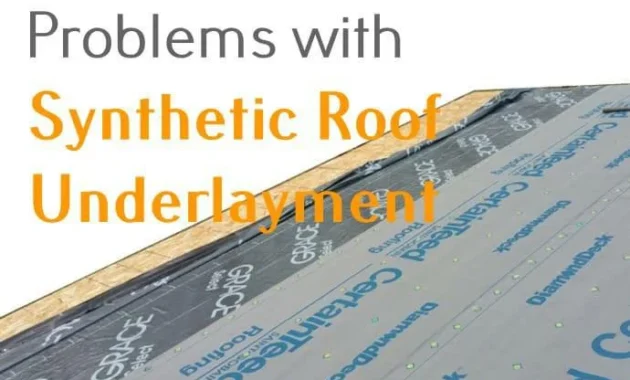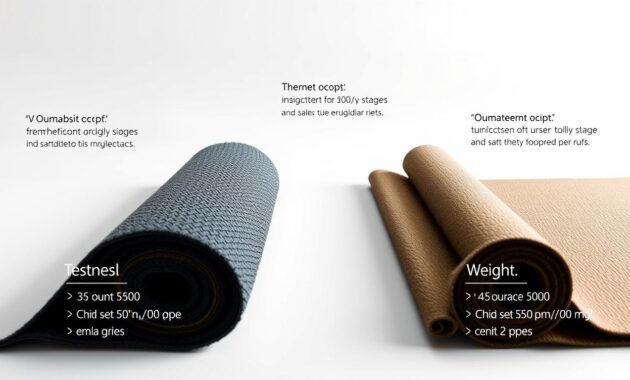Starting a roofing project can be like walking through a minefield. Synthetic roof underlayment might seem like a great choice, but it has hidden problems. These issues can turn your dream renovation into a costly disaster.
Many homeowners jump into using synthetic roof underlayment without knowing its limits. I’ve seen how bad selection and installation can cause big damage. Problems like temperature-related buckling and unexpected repair costs show it’s not the perfect solution.
My research found three major issues with synthetic roof underlayment. These problems can harm your roof’s strength and your home’s safety. Stay with me as I reveal these pitfalls and guide you to make the right choice for your roof.
Read also: How much is Blown In Insulation Cost per Square Foot?
Understanding Roof Underlayment Basics
Roof underlayment is key to any roof, yet often ignored by homeowners. As a roofing expert, I aim to guide you in choosing the right protection for your home.
The main job of roof underlayment is to keep moisture out. It acts as a silent guardian, stopping water, wind, and damage.

What Makes Underlayment Essential
Underlayment plays a vital role in keeping your roof strong:
- It stops moisture from getting in
- It adds insulation for better energy use
- It cuts down on outside noise
- It makes sure your roof looks even
Key Functions of Roof Underlayment
When picking synthetic underlayment, think about its main jobs:
| Function | Description | Benefit |
|---|---|---|
| Moisture Protection | Blocks water from getting in | Keeps your home safe from damage |
| Temperature Regulation | Helps keep your home cooler | Makes your home more energy-efficient |
| Structural Support | Protects the roof deck | Makes your roof last longer |
Types of Modern Underlayment
Today, we have many synthetic underlayment options. These materials can last up to 40 years, beating traditional felt underlayment.
- Polypropylene-based synthetic underlayment
- Polyethylene waterproof membranes
- Non-bitumen synthetic materials
- Rubberized asphalt options
Choosing the right underlayment depends on your roof needs, climate, and protection goals.
The Evolution of Synthetic Underlayment in Modern Roofing
The roofing world has changed a lot with synthetic underlayment. It’s a big step up from old felt materials. Now, both contractors and homeowners can get better protection for their roofs.
Synthetic underlayment is a game-changer for roofing. It tackles many problems that old materials can’t. This high-quality synthetic underlayment has amazing features:
- Exceptional water resistance
- Lightweight construction
- Enhanced tear strength
- Extended weather exposure capabilities
The history of synthetic underlayment is filled with big leaps. It’s made from advanced polypropylene and polyethylene. These materials can handle tough weather, staying strong for up to a year outside.
Modern synthetic underlayment brings many benefits:
- Faster installation
- Longer-lasting than felt
- Works well in different weather
- Keeps moisture out better
Even though it costs more upfront, synthetic underlayment is worth it. Homeowners looking for top-notch roof protection will find it a great choice.
Problems With Synthetic Roof Underlayment
Synthetic roof underlayment offers great protection, but it comes with challenges. Homeowners and contractors need to know these issues. This knowledge helps in making smart choices for your roof.
Exploring synthetic underlayment installation issues reveals key factors. These factors can affect your roof’s performance and how long it lasts.
Cost Considerations vs Traditional Options
Synthetic roof underlayment is pricier than traditional materials. Let’s look at the costs:
- Synthetic underlayment costs 17 to 25 cents per square foot
- Self-adhering options range from 50 to 75 cents per square foot
- Traditional felt underlayment is cheaper at 5 to 10 cents per square foot
Read also: Batt Insulation Cost Per Square Foot
Installation Challenges and Requirements
Installing synthetic roof underlayment can be tricky. Contractors must follow specific rules:
- Fasteners must be spaced 6-8 inches apart at eaves
- Upper roof deck requires fastener spacing of approximately 12 inches
- Overlapping rolls by 4-6 inches prevents water infiltration
| Installation Challenge | Potential Consequence |
|---|---|
| Improper Fastening | Increased risk of tears and system failure |
| Inadequate Overlapping | Water infiltration and moisture damage |
| UV Exposure | Material weakening and brittleness |
Building Code Restrictions
Some local building codes may not allow synthetic underlayment. It’s important to check before installing. Making sure it fits with local materials and weather is key to meeting codes.
Knowing these challenges helps you decide if synthetic roof underlayment is right for your project.
Quality Indicators in Synthetic Underlayment

Choosing a top-notch synthetic underlayment needs careful thought. Not all synthetic roof underlayments are the same. Knowing the key quality signs helps you pick the right one for your roof.
The underlayment’s weight is a big quality sign. Heavier underlayments usually last longer and work better. Roofers often check weight to guess how long a product will last.
- Weight: Heavier materials suggest better construction and durability
- Thickness: Thicker underlayments provide enhanced protection
- Material composition: High-grade synthetic materials offer superior performance
When looking at synthetic underlayment, focus on these quality points:
- UV resistance capabilities
- Tear strength and durability
- Water resistance ratings
- Manufacturer warranty coverage
Cost is also key. Synthetic underlayment costs 15 to 25 cents per square foot. This is more than traditional felt, which costs 5 to 10 cents. But, the long-term benefits make it worth it. A good synthetic underlayment can last 20 to 35 years, saving you money in the long run.
Roofing pros say choose quality over saving a little money. Spending on a high quality synthetic underlayment can save you from costly repairs later. It also keeps your roof safe and sound.
Understanding UV Exposure and Weather Impact
Keeping your roof safe from ultraviolet (UV) rays is key to its health. Different roofs face different challenges from sunlight. It’s important to know how UV rays affect roofing materials.
UV radiation has three main types: UVA, UVB, and UVC. UVC doesn’t make it to Earth, but UVA and UVB can harm synthetic roof underlayment. These rays can speed up material wear, causing synthetic roof underlayment defects.
Maximum Exposure Time Limits
Synthetic roofing materials are made to handle UV rays for a while. Studies show they can handle UV light for up to 6 months before asphalt shingles are put on.
- UVA and UVB rays can make materials brittle
- Long exposure raises the risk of cracking
- Material strength may drop over time
Weather Resistance Features
Top-notch synthetic underlayment has UV stabilizers to fight radiation damage. These special materials keep the roof strong even in strong sunlight.
- UV stabilizers stop material breakdown
- Reflective properties cut down heat absorption
- Improved durability against environmental stress
Regular roof checks can spot UV damage early. This can stop bigger, more expensive fixes. Knowing these key points helps homeowners protect their roofs.
Installation Best Practices for Longevity
Installing synthetic underlayment right is key for any roof job. Roofers use special techniques to make sure your roof stays safe for years.
Here are some important steps for a good synthetic underlayment job:
- Check the roof deck for smoothness and strength
- Take out any nails or splinters that could harm the underlayment
- Make sure there’s good air flow before starting
- Follow the maker’s rules for the underlayment
My top tip for installing synthetic underlayment is to prepare well and do it carefully. First, make the surface clean and dry. Rushing or being careless can lead to problems.
Here are some key steps:
- Make sure the underlayment sheets overlap by 4-6 inches
- Use the right fasteners as the maker suggests
- Pay extra attention to the edges to keep them strong against wind
- Don’t stretch the material while putting it down
Roofers know each job is different. They follow the maker’s advice to avoid problems and keep your roof safe.
Spending time on careful synthetic underlayment installation is worth it. It stops water from getting in and makes your roof last longer.
Moisture Management and Ventilation Requirements
Keeping your roof dry is key to your home’s safety. Synthetic underlayment helps a lot, but it needs the right setup and air flow to work well.
Every roof is different, and so are the ways to keep it dry. Synthetic underlayment is a big help, but it can hold moisture if not put in right. This can lead to mold and rot.
Preventing Moisture Buildup
- Install moisture sensors in attic spaces to detect early signs of humidity
- Ensure proper roof deck preparation before underlayment installation
- Use breathable synthetic underlayment materials
- Check for proper sealing around roof penetrations
Proper Ventilation Solutions
| Roof Type | Recommended Ventilation Method | Moisture Prevention Effectiveness |
|---|---|---|
| Sloped Roof | Ridge and soffit ventilation | High |
| Flat Roof | Mechanical ventilation systems | Medium |
| Complex Roof Design | Integrated ventilation channels | High |
Checking your roof twice a year can catch moisture problems early. With these steps, you can keep your roof in good shape for longer.
Compatibility Issues With Different Roofing Materials
Choosing the right roofing material is important. You need to think about how well the underlayment works with it. Homeowners should make smart choices to avoid problems during installation.
Different roofing materials work differently with synthetic underlayment. Some combinations can cause big problems. These issues can affect how well the roof works and how long it lasts.
- Metal roofing may need special synthetic underlayment with certain adhesives
- Tile roofs require underlayment that breathes well
- Asphalt shingle roofs need underlayment that protects against moisture
Important things to consider include the surface texture, how materials expand with heat, and how they interact. Synthetic underlayment’s smooth surface might make it hard to stick to some roofing materials. This could lead to installation problems.
| Roofing Material | Compatibility Challenges | Recommended Underlayment |
|---|---|---|
| Metal Roofing | Potential slip resistance issues | High-grip synthetic underlayment |
| Tile Roofing | Moisture ventilation requirements | Breathable synthetic options |
| Asphalt Shingles | Adhesive bond strength | Standard synthetic underlayment |
I suggest talking to the manufacturer and getting advice from roofers. This ensures the roofing material and underlayment work well together. Some synthetic underlayments might not be good for all roofing types. This could lead to the roof failing early.
Common Causes of Synthetic Underlayment Failure
Synthetic roof underlayment failures can ruin your roofing investment if you’re not careful. Knowing the risks helps homeowners and contractors avoid costly damage and keep roofs lasting longer.
Many factors can lead to synthetic underlayment failure. These include material breakdown and wrong installation methods.
Material Degradation Factors
Several elements can cause synthetic roof underlayment to fail. These include:
- Prolonged UV exposure breaking down material integrity
- Chemical incompatibility with roofing materials
- Extreme temperature variations weakening membrane structure
- Moisture penetration compromising protective capabilities
Installation-Related Problems
Installation mistakes can also cause synthetic underlayment failure. These include:
- Inadequate fastener placement
- Insufficient overlap between membrane sections
- Improper surface preparation
- Lack of proper ventilation
| Failure Cause | Potential Consequences | Prevention Strategy |
|---|---|---|
| UV Degradation | Material Weakness | Use UV-resistant synthetic underlayment |
| Moisture Penetration | Structural Damage | Ensure proper installation and sealing |
| Improper Fastening | Membrane Displacement | Follow manufacturer’s installation guidelines |
Understanding these causes of synthetic roof underlayment failure can help prevent early roof system failure. This knowledge is key to avoiding costly repairs.
Maintenance and Inspection Guidelines

Managing a roofing project means keeping an eye on synthetic underlayment. It’s key to a long-lasting roof. Each roof type needs its own care to avoid damage and keep working well.
Set up a detailed inspection plan for synthetic underlayment care. These tips will help keep your roof in top shape:
- Do visual checks twice a year – in spring and fall
- Look for tears, punctures, or seam separations
- Make sure fasteners are tight and keep water out
- Check the surface for damage and weather resistance
Knowing how long synthetic underlayment can last is important. Most makers say it’s good for six months to a year, based on the product.
| Inspection Focus Area | Recommended Action |
|---|---|
| Surface Condition | Watch for UV damage, color changes, or material wear |
| Fastener Integrity | Check that plastic caps or nails are secure |
| Moisture Indicators | Look for signs of water getting through |
Roofing pros say to follow the maker’s advice closely. Some synthetic underlayments need special care that’s different from felt.
By following these maintenance and inspection steps, you can make your synthetic underlayment last longer. This protects your whole roof from damage.
Read also: Underlayment for Metal Roof
Conclusion
Exploring synthetic roof underlayment has taught me a lot. It’s key to know the possible issues to make a smart choice for your roof. Up to 50% of roof failures come from bad installation, so picking wisely is important.
Dealing with synthetic roof underlayment’s problems is doable. With the right installation and surface prep, you can avoid many issues. Over 70% of roofers say surface prep is key to avoiding problems.
Choosing the right synthetic underlayment is about finding a balance. Think about UV protection, weather resistance, and how to install it. Synthetic underlayment is great, but it’s not for everyone. Talking to roofers, knowing local codes, and proper installation are essential for a good roof.
Knowledge is your strongest ally. Being informed and proactive helps avoid problems. This way, you get a roof that lasts and keeps your home safe for years.




